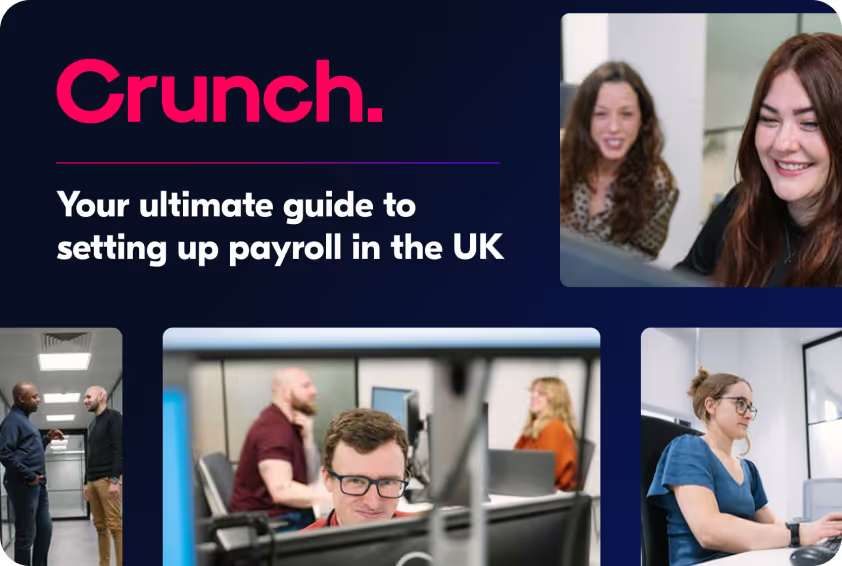Running your own payroll can seem intimidating if you’ve never done it before. Tax codes, National Insurance, Real Time Information, the terminology alone can be overwhelming. But for many small businesses in the UK, handling payroll in-house can be a practical, cost-effective solution, provided you understand what’s required and use the right tools.
In this guide, we’ll take you through everything you need to know about doing your own payroll: from registering with HMRC and setting up your system, to paying employees, submitting information, and staying compliant.
By the end, you’ll know exactly what’s involved, and whether it’s the right approach for your business.
{{payroll-guide}}
Why payroll matters for small businesses
Payroll isn’t just about transferring money to your team each month. It’s also about making sure the correct taxes, National Insurance contributions, and pension deductions are made and reported accurately to HMRC.
Every UK employer is legally required to follow Real Time Information (RTI) reporting rules, meaning every time you pay an employee, you must also tell HMRC how much you’ve paid them, and what deductions you’ve made. Failing to do so can lead to penalties and unnecessary stress, not to mention unhappy employees if their pay is wrong or late.
But accurate payroll also plays a key role in your financial management. It ensures your accounts reflect true employment costs and that your business cash flow is predictable. Doing payroll correctly helps you build trust with staff, stay compliant, and maintain a clear financial picture.
Step one: registering as an employer
Before you can pay anyone, even yourself, if you’re a limited company director, you’ll need to register as an employer with HMRC. This applies whether you have one employee or ten, and even if you’re paying yourself below the National Insurance threshold.
The registration process is done online via the HMRC website. You’ll need details about your business, including your trading name, address, and company registration number (if you have one). Once you’ve registered, HMRC will issue you with:
- An Employer PAYE Reference, which identifies your payroll scheme.
- An Accounts Office Reference, used when you make payments to HMRC.
This process can take up to two weeks, so it’s best to do it well before your first payday. Once you’ve received your details, you’ll also be able to access HMRC’s PAYE Online service, where you can check your submissions, track payments, and manage any queries.
Step two: setting up your payroll system
Next, you need a way to calculate pay, deductions, and HMRC submissions accurately. Technically, you could do this manually using spreadsheets and HMRC’s basic PAYE tools, but that approach quickly becomes cumbersome, and prone to errors.
Most small businesses use payroll software, which automates calculations and ensures compliance with the latest tax rates and thresholds. Many accounting platforms have built-in payroll modules that handle everything from payslip generation to RTI submissions automatically.
When choosing software, make sure it can:
- Calculate PAYE tax, National Insurance, and pension deductions automatically.
- Submit RTI data directly to HMRC.
- Generate compliant payslips.
- Produce end-of-year reports, such as P60s and P11Ds.
Integrated systems also mean that payroll costs flow directly into your accounts, so you always have an accurate view of your expenses and tax position.
Step three: gathering employee information
To run payroll correctly, you’ll need accurate information for every employee. This includes full name, address, date of birth, National Insurance number, and bank details for payments. You’ll also need their tax code, which dictates how much income tax they should pay. If the employee is new, they’ll usually provide a P45 from their previous employer. If not, you’ll need them to fill out HMRC’s starter checklist to determine their initial code.
Keep secure copies of employment contracts, start dates, and any benefit arrangements. If you operate a workplace pension, you’ll also need to determine whether each employee is eligible for auto-enrolment and ensure they’re added to the scheme on time.
Step four: deciding how and when to pay
You’ll need to decide how often to pay your employees, monthly is standard, but some small businesses prefer weekly or fortnightly pay runs. The key is consistency: stick to your chosen schedule, as it affects your RTI submission dates and HMRC payment deadlines.
Each pay period, you’ll calculate gross pay (the amount before deductions), apply any relevant deductions, and arrive at the net pay, the amount you’ll actually transfer to your employee. Deductions typically include:
- Income tax (PAYE)
- Employee National Insurance contributions
- Pension contributions, if applicable
- Student loan repayments, if required
You’ll also need to account for employer National Insurance and any employer pension contributions. Payroll software automates these calculations and keeps them updated in line with current thresholds, which change each tax year.
Step five: submitting real time information (RTI)
Under RTI rules, you must tell HMRC about payments and deductions every time you pay employees, not just at the end of the tax year. This is done via a Full Payment Submission (FPS), which is sent electronically from your payroll software.
If adjustments or statutory payments (like maternity pay or sick pay) apply, you might also need to send an Employer Payment Summary (EPS). These submissions must be made on or before the employee’s payday. Late or missing RTI submissions can result in penalties or incorrect tax records.
HMRC uses this information to update employees’ tax accounts in real time, ensuring that their personal tax calculations remain accurate.
Step six: paying HMRC and pension providers
After processing payroll and submitting your RTI, you’ll need to pay HMRC the total amount of tax, National Insurance, and other deductions owed. Most small employers pay monthly, with the payment due by the 22nd of the following month (or the 19th if paying by post).
If you’re running a workplace pension, you must also transfer both employer and employee pension contributions to your pension provider within the deadlines they specify, usually within a few days of each pay run.
Keeping up with these payments is critical. Missing deadlines or underpaying can lead to interest charges and enforcement action. Payroll software usually provides clear summaries of what you owe and when, so it’s easy to stay organised.
{{dividend-tax-calculator}}
Step seven: record keeping and compliance
By law, you must keep detailed payroll records for at least three years after the end of the tax year they relate to. These records should include employee details, payments, deductions, RTI submissions, and evidence of pension contributions.
Good record keeping protects you if HMRC carries out a compliance check, but it also makes your own accounting simpler, for example, reconciling payroll costs in your financial statements or dealing with employee queries about past payslips.
Many modern systems (including Crunch’s platform) handle this automatically, keeping secure digital records that meet HMRC’s requirements.
Step eight: handling year-end tasks
At the end of the tax year, which runs from 6 April to 5 April, you’ll have a few extra tasks to complete. You must issue P60 forms to all employees who were on your payroll on 5 April. A P60 summarises their pay and deductions for the year and must be given to them by 31 May.
If any employees received taxable benefits (such as company cars or private healthcare), you may also need to complete a P11D form and submit it to HMRC by 6 July. Your payroll software can usually generate these automatically.
Finally, make your final RTI submissions, check that all HMRC payments are up to date, and prepare for the new tax year. This is a good time to review any changes in rates, thresholds, or employee details before the first payroll run in April.
Common mistakes to avoid
The most frequent payroll mistakes among small businesses are simple but costly. Forgetting to submit an RTI on time, using an incorrect tax code, or miscalculating pension contributions can all result in fines or unhappy employees.
Another common oversight is neglecting to keep payroll records properly, or failing to update employee details when circumstances change, for instance, when someone moves, changes tax code, or starts repaying a student loan.
A good rule of thumb is to always double-check your first few payroll runs and rely on automation where possible. Software that integrates with your accounting system can save significant time and reduce errors.
Should you do payroll yourself or outsource?
Handling payroll in-house makes sense for many microbusinesses, particularly those with only one or two employees, or directors paying themselves a regular salary. It can save money and give you complete control.
However, as your business grows, payroll can become more complex. Multiple employees, different pay frequencies, bonuses, statutory pay, and benefits all add layers of admin. In these cases, outsourcing can be a smart investment.
At Crunch, we offer a managed payroll service designed specifically for small businesses and limited company directors. We handle all your filings, submissions, and payslips, ensuring everything is accurate and on time, so you can focus on running your business instead of worrying about deadlines and deductions.
Doing your own payroll in the UK isn’t as difficult as it might seem, but it does require diligence, organisation, and the right tools. With a solid understanding of the process and good software, you can confidently manage payroll for your small business while staying compliant and avoiding penalties.

.svg)



.webp)















